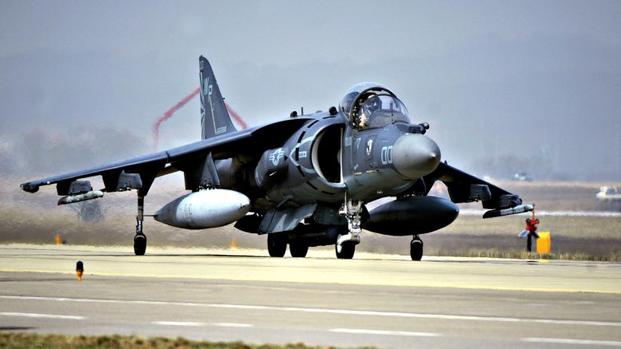A command investigation into the Sept. 22, 2016, crash of a Marine Corps AV-8B Harrier off Okinawa found that the pilot abruptly lost control of the aircraft around 13,000 feet, spiraling until ejection 1,800 feet above the water.
The crash, which did not injure the pilot but destroyed the Harrier, prompted the commander of III Marine Expeditionary Force, Lt. Gen. Lawrence Nicholson, to order a "temporary operational pause" for all AV-8Bs in the region.
It came just months after the May 2016 crash of a Harrier off the coast of North Carolina, which also resulted in a pilot ejection.
A heavily redacted version of the command investigation into the Sept. 22 crash, completed in April but not released to Military.com until this month, reveals little conclusive about the cause of the mishap. The aircraft, which ended up underwater, could not be inspected, leaving the investigator to rely on witness accounts and paperwork.
The Harrier, attached to Marine Attack Squadron 542, out of Cherry Point, North Carolina, had been deployed with the 31st Marine Expeditionary Unit at the time of the crash.
The mishap flight, however, originated from the ground. The mission of the day was a one-on-one, air-to-air tactics flight launching from Kadena Air Base in Japan.
The pilot of the mishap aircraft had joined the squadron in July 2015 and, like most of the Harrier community, was short on recent hours flown going into the mission. According to documents, the pilot had flown six hours in the previous 30 days, and just 13.3 hours total in the previous 60 days.
At the time of the crash, monthly pilot flight hours on the Harrier averaged 13, shy of the 15.4-hour goal, according to a Marine official.
The aircraft had four outstanding orders for maintenance, according to the investigation, but none deemed to pose a flight hazard. Problems requiring maintenance included two broken anchor nuts, a crack on an aft wall, and a crack on a water pipe bracket.
The mission of the day included multiple beyond-visual-range radar intercepts.
On the third intercept, the pilot of the mishap plane was flying level at 14,000 feet when he spotted the other aircraft to his right. He throttled to military power, the highest aircraft power setting without afterburners, and hit a sharp right turn to merge with the other aircraft.
Soon after, he lost sight of the other plane and began to conduct maneuvers in order to regain a visual: slowing down in the turn, moving throttle to idle, inverting, then eventually moving back to full military power. With his nose low and at that high power setting, he lost control of the aircraft, according to the investigation.
The experience was "extremely disorienting," the pilot told investigators. And while Harriers are known to depart controlled flight at too-extreme angle-of-attack levels, the pilot said he did not remember hearing any of the cockpit warnings or cautions designed to precede such an event.
After the pilot lost control, he was coached on the radio up to the point of ejection more than a minute later. He never regained full control of the aircraft, however.
"The jet did not recover, and departure progressed into an upright spin to the right," the pilot said in a statement to investigators. "... I entered and held anti-spin inputs until the jet showed no sign of recovery."
While the cause of the crash was not explicitly stated, the investigators discussed potential problems that can exacerbate angle-of-attack limits and potentially cause an aircraft to stop responding to controls. External fuel tanks were one such factor, the report found.
It also discussed "lag" scenarios following extreme maneuvering in which the angle of attack shown on the pilot's head-up display is less than the actual angle of attack, possibly allowing the aircraft to reach stall conditions without the pilot's knowledge.
While the command redacted much of the discussion by unit commanding officers about the investigation, both the 31st MEU commander and Nicholson praised the efforts of the Japanese Self-Defense Force, which dispatched aircraft to help Air Force assets pull the pilot uninjured from the water.
"This unfortunate incident highlights the close cooperation and professionalism between the Japanese Self-Defense Force, our sister service, and the Marine Corps to swiftly render assistance to the mishap pilot and retrieve him from the water," Col. Tye Wallace, commander of the 31st MEU, wrote in an endorsement of the report.
"I am confident of this continued high level of cooperation and professionalism between our host nation partners and sister service in the future," he added.








